Nancy Moser's Blog, page 4
March 23, 2013
Easter ... a re-post, a reminder
If you are new to "Footnotes from History," this will be a new post. If not, then you may remember is from last year ... but I still need the reminder (as I plan Easter baskets for my grandkids). If you are like me, you often re-read books or re-watch movies. I hope you won't mind a re-run here.Human History's Crowning EventNext weekend we'll be commemorating the single most important event in all of human history. A first century itinerant teacher's death. But don't forget the rest of that bit of history. Jesus wasn't just a great teacher. He also created the known universe. He was the only One who could solve my sin problem, and He did it ... and then He proved it by leaving the empty tomb. Imagine. Climbing out of one's own grave. The ultimate "it is finished." I've spent a great part of my adult life trying to wrap my brain around that concept and I just can't do it. Faith has to step in at some point, because it just isn't humanly comprehensible. Which is OK by me. Who needs a God they can explain.
Listening to this song makes me think of the apostles gathered in a dark place. Hiding away ... and wishing they could see a way through the darkness that descended with Jesus--their hope--lay in a tomb. Thought I'd share that song with you as part of this unconventional post.
_______________________________________
In one of my former lives I was a secretary at the University of Nebraska (back in the day we were still called secretaries). One of my bosses was a devout Roman Catholic whose wife wrote an award-winning column for the local newspaper. I'd like to share her 1986 column about Easter. It isn't intended to spoil the fun ... fun is great ("He gives us all good things to richly enjoy"). But it's also a challenge to remember the primary purpose for this season we celebrate every spring. Mrs. Costello was the mother of a tribe of kids, and I hear her challenging herself with these words. To remember the primary purpose. Wisdom from over a quarter of a century ago by one Mary Costello:___________________________________ Two thousand years ago, an itinerant preacher was hanged as a common criminal. He died on some trumped-up charges, probably because he was different. Mainly, the problem was he didn't fit in with those in authority, and they were afraid of him. He was going around the countryside doing some strange things and stirring up trouble. So they thought they'd better get rid of him--as quickly and as efficiently as possible.
And that's how we continue to commemorate his death--as quickly and efficiently as possible. "Oh, yes. Good Friday. I remember that. But I have to work."
This man, who was God, died for us. To redeem us, and to bring us to his father. And we remember his death with pink stuffed bunnies and chocolate eggs.
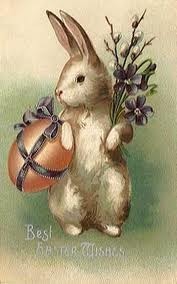 He was tortured, hung on a cross with nails in his hands and feet. He was beat with a whip and tortured with a helmet of nails pushed into his scalp. I'll try to remember that between commercials on "Miami Vice" Friday night.
He was tortured, hung on a cross with nails in his hands and feet. He was beat with a whip and tortured with a helmet of nails pushed into his scalp. I'll try to remember that between commercials on "Miami Vice" Friday night.His mother placed him in the tomb and arranged the clothes around him with her own hands. Well, some businesses do close at noon on Good Friday.
After three days in the tomb, the preacher rose from the dead. It was the most magnificent, glorious miracle in the history of mankind. To celebrate that event, I'll get all the kids new shoes.
It was an event that changed the course of history, for all time. It was the focal point, the turning point of man's existence. "Church on Easter. Yes, that would be nice. All the little girls in their bonnets and pink sweaters. But we'll probably just sleep in--haven't had a Sunday off in ages."
His resurrection says to us: "Have hope. I love you. I came to save you; to bring you to heaven with me." So we dig out the little plastic baskets, fill them with green plastic grass and arrange chocolate eggs and jelly beans. Jelly beans have become a great symbol of hope to all Americans. Does that strike you as strange?
To everyone he met, after he rose and left the tomb, he said, "My peace be with you." In memory of that, and to bring peace into my own life, I will spend the entire week before Easter dashing around town, buying candy and eggs and shoes and new stockings to match dresses that will only be worn once, and we will spend Sunday eating too much and fighting over who ate all the marshmallow chicks.
His friends were so happy to see him, they cried. They understood. Between the egg hunt and the ham and scalloped potatoes, if I have a minute, I'll try to remember how they felt.
He lived and died for us, so that we might have life everlasting, but also so that our lives could be filled with hope and peace and joy. In the weeks after Easter--when the world is filled with new life and tiny blue lilac buds, and palest green grass and all the wonders spring brings to us--I'll try to remember his life, and what it has taught me. I hope it's more than pink stuffed bunnies.________________________________
In these approaches our celebration of His resurrection, may you
Published on March 23, 2013 09:51
February 3, 2013
Pride in "Pride & Prejudice"
Two hundred years ago, one of my favorite stories by one of my favorite authors was published. Pride & Prejudice. If you haven't read the book, I'm betting you've seen either the movie or the series.
Most people have a preference as to favorite actors playing their favorite characters. For fun I thought I'd compare the two versions and vote on which version of the characters were my favorites.
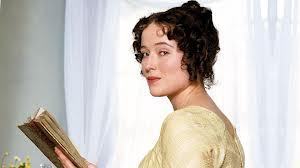
SERIES: Elizabeth Bennet--Jennifer Ehle. WINNER. It was was a very bright and strong portrayal.
 MOVIE: Elizabeth Bennet – Keira KnightlyNot enough of a presence in the movie.
MOVIE: Elizabeth Bennet – Keira KnightlyNot enough of a presence in the movie.
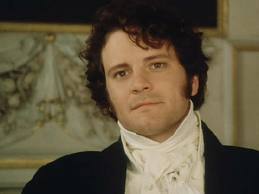
SERIES: Mr.Darcy – Colin Firth WINNER THE Mr. Darcy. There is no other.Ask anyone.
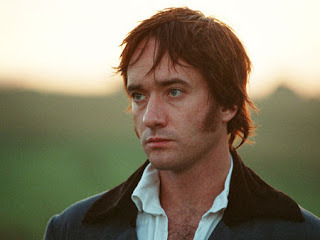
MOVIE: Mr. Darcy -- Matthew Macfadyen
Very handsome, but no one can
top Colin Firth. Sorry abou that.
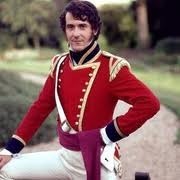 SERIES: Mr. Wickham -- Adrian Lukis
SERIES: Mr. Wickham -- Adrian Lukis
Very charming and sleazy.
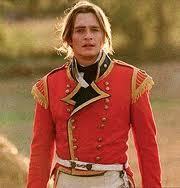 MOVIE: Mr. Wickham – Rupert Friend WINNER. I might be prejudiced, but seeing him in “Young Victoria” makes me a forever fan
MOVIE: Mr. Wickham – Rupert Friend WINNER. I might be prejudiced, but seeing him in “Young Victoria” makes me a forever fan
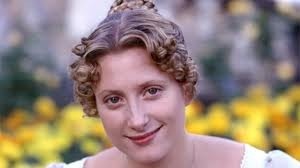 SERIES: Jane Bennet -- Susannah HarkerSweet, but hated the hair so much I couldn't believe she was the "pretty one"even though she is very pretty. She seemed kind of vacant.
SERIES: Jane Bennet -- Susannah HarkerSweet, but hated the hair so much I couldn't believe she was the "pretty one"even though she is very pretty. She seemed kind of vacant. 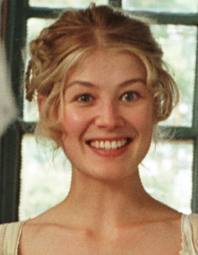 MOVIE: Jane Bennet -- Karen Wasyloski WINNERSo lovely and sweet. Had some life in her.
MOVIE: Jane Bennet -- Karen Wasyloski WINNERSo lovely and sweet. Had some life in her.
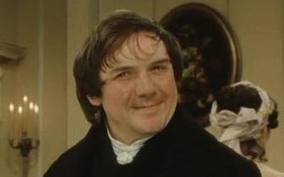
SERIES: Mr. Collins -- David Bamber WINNER
Again, the hair was a factor. So greasy
and icky. And he was so fawning I simply
had to be disgusted by him.
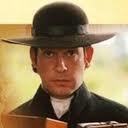 MOVIE: Mr. Collins -- Tom Hollander
MOVIE: Mr. Collins -- Tom Hollander
Just didn't buy it.
The other sisters, the mother and father, Mr. Bingley . . . the actors in both versions did fine.
The costumes? Although the bodices in the TV series were sometimes too stiff, the sacks that passed for everyday dresses in the movie made the Bennets look far poorer than they were.
Overall, the mini-series wins hands down. I just don't think you can edit this wonderful story down to a 2 hour movie. What do you think?
To cap off my opinion . . . here's one of my favorite pictures of Lizzie and Mr. Darcy's wedding. True love does exist!
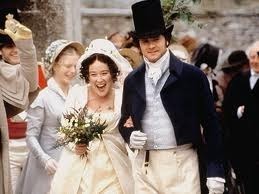
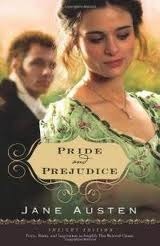 If you haven't read the book, there are hundreds of versions, but one I love is an annotated version that has interesting and sometimes funny comments and trivia.
If you haven't read the book, there are hundreds of versions, but one I love is an annotated version that has interesting and sometimes funny comments and trivia.
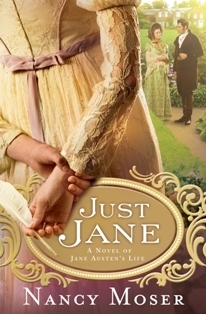 Also, if you'd like to read a biography of Jane Austen, that's factual but reads like a novel (it's Jane telling her life story), try my novel,
Just Jane
. If you'd like to read an excerpt, click here.
Also, if you'd like to read a biography of Jane Austen, that's factual but reads like a novel (it's Jane telling her life story), try my novel,
Just Jane
. If you'd like to read an excerpt, click here.
There's good reason that Jane's stories have lasted 200 years./Nancy
Most people have a preference as to favorite actors playing their favorite characters. For fun I thought I'd compare the two versions and vote on which version of the characters were my favorites.

SERIES: Elizabeth Bennet--Jennifer Ehle. WINNER. It was was a very bright and strong portrayal.
 MOVIE: Elizabeth Bennet – Keira KnightlyNot enough of a presence in the movie.
MOVIE: Elizabeth Bennet – Keira KnightlyNot enough of a presence in the movie.

SERIES: Mr.Darcy – Colin Firth WINNER THE Mr. Darcy. There is no other.Ask anyone.

MOVIE: Mr. Darcy -- Matthew Macfadyen
Very handsome, but no one can
top Colin Firth. Sorry abou that.
 SERIES: Mr. Wickham -- Adrian Lukis
SERIES: Mr. Wickham -- Adrian LukisVery charming and sleazy.
 MOVIE: Mr. Wickham – Rupert Friend WINNER. I might be prejudiced, but seeing him in “Young Victoria” makes me a forever fan
MOVIE: Mr. Wickham – Rupert Friend WINNER. I might be prejudiced, but seeing him in “Young Victoria” makes me a forever fan  SERIES: Jane Bennet -- Susannah HarkerSweet, but hated the hair so much I couldn't believe she was the "pretty one"even though she is very pretty. She seemed kind of vacant.
SERIES: Jane Bennet -- Susannah HarkerSweet, but hated the hair so much I couldn't believe she was the "pretty one"even though she is very pretty. She seemed kind of vacant.  MOVIE: Jane Bennet -- Karen Wasyloski WINNERSo lovely and sweet. Had some life in her.
MOVIE: Jane Bennet -- Karen Wasyloski WINNERSo lovely and sweet. Had some life in her. 
SERIES: Mr. Collins -- David Bamber WINNER
Again, the hair was a factor. So greasy
and icky. And he was so fawning I simply
had to be disgusted by him.
 MOVIE: Mr. Collins -- Tom Hollander
MOVIE: Mr. Collins -- Tom HollanderJust didn't buy it.
The other sisters, the mother and father, Mr. Bingley . . . the actors in both versions did fine.
The costumes? Although the bodices in the TV series were sometimes too stiff, the sacks that passed for everyday dresses in the movie made the Bennets look far poorer than they were.
Overall, the mini-series wins hands down. I just don't think you can edit this wonderful story down to a 2 hour movie. What do you think?
To cap off my opinion . . . here's one of my favorite pictures of Lizzie and Mr. Darcy's wedding. True love does exist!

 If you haven't read the book, there are hundreds of versions, but one I love is an annotated version that has interesting and sometimes funny comments and trivia.
If you haven't read the book, there are hundreds of versions, but one I love is an annotated version that has interesting and sometimes funny comments and trivia.  Also, if you'd like to read a biography of Jane Austen, that's factual but reads like a novel (it's Jane telling her life story), try my novel,
Just Jane
. If you'd like to read an excerpt, click here.
Also, if you'd like to read a biography of Jane Austen, that's factual but reads like a novel (it's Jane telling her life story), try my novel,
Just Jane
. If you'd like to read an excerpt, click here.There's good reason that Jane's stories have lasted 200 years./Nancy
Published on February 03, 2013 18:09
December 3, 2012
A Gift to Give Yourself
A Note from Stephanie:
In the middle of the madness that will be December (in spite of our best efforts to control it), I hope that you will find time to give yourself a gift, too—time with a favorite book. Time with your feet propped up. Time with a cup of joe or cocoa or tea. Time. The best gift of all.
I thought I’d share two of the books I return to at this time of year (and why).
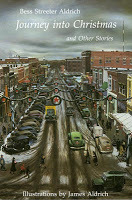 Journey into Christmas by Bess Streeter Aldrich.
Journey into Christmas by Bess Streeter Aldrich. Bess Streeter Aldrich is my favorite story-teller. She’s “the other Nebraska author” that few seem to know about. (Everyone knows about Willa Cather.) Aldrich is “softer.” Her stories are gentle and filled with hope. Journey into Christmas (first published in 1949) is a collection of short stories guaranteed to bring tears to your eyes and encouragement to your soul. The themes are timeless (difficult economies and tough times) but hope reigns eternal. And hope wins. Aldrich’s gift with imagery resonates with me. For example:
“Bellfield is similar to a hundred other small Midwestern towns. From the air its building look like so many dishes clustered together on a flat table. The covered soup tureen is the community hall. The red vase in the center is the courthouse. The silver-tipped salt shaker is the water tank. There are few changes in the ensemble from year to year. Only the tablecloth is different. There is a vivid green one for spring, a checkered green-and-tan one for summer, a mottled yellow-red-and-brown one for autumn. Just now—the day before Christmas—nature, the busy housekeeper, had dressed the table in a snow-white cloth for the first time …”
In another story, where children think that Christmas has become too much work for their 81-year-old mother and decide they won’t be going home for Christmas, Aldrich writes, “…not one had understood how much less painful it is to be tired in your body than to be weary in your mind—how much less distressing it is to have an ache in your bones than to have a hurt in your heart.” Never fear, though—Aldrich always treats her readers to a happy ending. If I could, I’d send a copy to every blog reader. I like it that much.
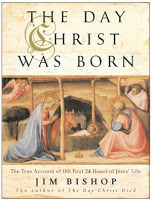 The Day Christ Was Born
by Jim Bishop.
The Day Christ Was Born
by Jim Bishop. “The road out of Bethany threw a tawny girdle around the hill they called the Mount of Olives and the little parties came up slowly out of the east leading asses with dainty dark feet toward the spendor of Jerusalem.” I’ve never been to the Holy Land, but with that opening and all the way to the end, I feel that I am seeing what Mary and Joseph saw as they journeyed toward Christmas. In addition, I begin to understand what Jerusalem meant (and means) to the Jewish people. Bishop’s Mary is a flesh-and-blood girl—not some other-worldly mythical figure I can’t relate to. In this book, Mary is faithful and aware of her heavenly Father’s care, but she’s also terrified and wondering. “God was everywhere. It gave Mary confidence to know that He was everywhere. She needed confidence. Mary was fifteen.” The book flap on my copy of this book says, “Bishop incorporates treasures of information … discovered by nineteen centuries of scholars in archaeology, linguistics and related disciplines, to create a tapestry woven from many threads of a gripping, ever-unfolding narrative that is biblically accurate yet filled with rich, dramatic, detail.” In plain language, Bishop’s account is the ultimate “you are there” experience (at least it is for me). He helps me see, hear, small, and feel what the most important event in all of human history might have been like for the real humans who lived it—Mary and Joseph, shepherds and Magi (in spite of the title, the story goes beyond that one day). Bishop provides the cultural context for the story in a way that helps me understand and appreciate “the players” far more than I ever have before. [Apparently the book is out of print, but abundant used copies are available online.]_____________________________
May your holidays be bright, and I hope you give yourself the gift of quiet time and reading.
What’s your favorite holiday reading?
Published on December 03, 2012 11:27
October 11, 2012
A Patchwork Christmas Collection
Announcing a new Book,
just in time for Christmas!
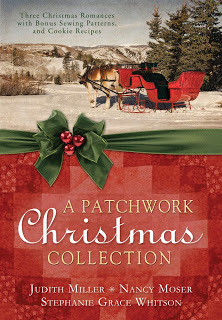 A PATCHWORK CHRISTMAS
A PATCHWORK CHRISTMAS
Stephanie and I (Nancy) are happy to announce a new novella collection by the two of us and Judith Miller. Three historical novellas that revolve around Christmas—and quilts! What evokes a cozier feeling than quilts? And as a bonus, in the back of the book are recipes and directions to make a crazy-quilt ornament, a pair of knitted Amana mittens, and a patchwork doll quilt!
• THE BRIDAL QUILT by Nancy Moser: A wealthy ingénue—the toast of 1889 New York—
inadvertently causes grave injury to a poor man who protects a street urchin from a rearing horse.
Remorse forces her to bring the man home, where she discovers he is someone she once considered quite a catch. Can she give up everything to love him?
• SEAMS LIKE LOVE by Judith Miller: Jilted by a faithless fiancé, Karla Stuke of the Amana
Colonies packs away her wedding quilt in 1890, her faith in men destroyed and her hope for marriage and children shattered. Until an apprentice pharmacist arrives in town. Does Frank Lehner have the saint’s patience he’ll need to change her mind?
* A PATCHWORK LOVE by Stephanie Grace Whitson: Jane McClure, widowed too soon, is headed west in 1875 to marry a prosperous businessman she barely knows in order to give her daughter a better life. Given shelter when a show storm strands them both, Jane worries that her chance is slipping away—and so does the homesteader who rescued her. Will she see what’s
right in front of her?
Plus...
Enter the PATCHWORK CHRISTMAS CONTEST!
In the back of A Patchwork Christmas Collection are the directions to make the following:
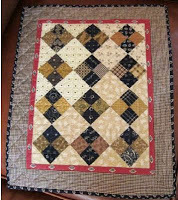 • a doll quilt like the one Molly makes in “A Patchwork Love” (one similar to this photo)
• a doll quilt like the one Molly makes in “A Patchwork Love” (one similar to this photo)
• a pair of mittens made from the Amana pattern mentioned in “Seams like Love”
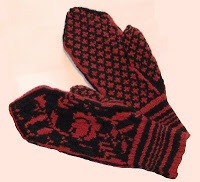
• a crazy quilt ornament made in the style of the quilt in my novella, “The Bridal Quilt.”
How would you like to win one of these items?
To enter the contest… you need to collect three KEY WORDS from each of our websites. Visit Nancy's at www.nancymoser.com, Stephanie's at www.stephaniewhitson.com and Judy's at www.Judithmccoymiller.com and collect the key words. Once you have collected all three key words, simply e-mail them to: apatchworkchristmas@gmail.com along with a shipping address
in case you win one of the three prizes. (You can state your preference of which prize you would prefer if you wish, but we cannot guarantee that we will be able to make that wish come true.) Your entry must arrive by noon on December 1, 2012. On December 2, 2012, a random drawing will award three entrants with either the doll quilt, the mittens, or the ornament. Good luck!
I’d also like to invite you to subscribe to our newsletters so that you will receive new book news-- but you do not need to subscribe to be eligible to win one of the three prizes.
Thanks for visiting, and may your holidays be bright.
Sign up for Nancy’s newsletter Sign up for Stephanie's newsletter Sign up for Judith's newsletter

just in time for Christmas!
 A PATCHWORK CHRISTMAS
A PATCHWORK CHRISTMAS
Stephanie and I (Nancy) are happy to announce a new novella collection by the two of us and Judith Miller. Three historical novellas that revolve around Christmas—and quilts! What evokes a cozier feeling than quilts? And as a bonus, in the back of the book are recipes and directions to make a crazy-quilt ornament, a pair of knitted Amana mittens, and a patchwork doll quilt!
• THE BRIDAL QUILT by Nancy Moser: A wealthy ingénue—the toast of 1889 New York—
inadvertently causes grave injury to a poor man who protects a street urchin from a rearing horse.
Remorse forces her to bring the man home, where she discovers he is someone she once considered quite a catch. Can she give up everything to love him?
• SEAMS LIKE LOVE by Judith Miller: Jilted by a faithless fiancé, Karla Stuke of the Amana
Colonies packs away her wedding quilt in 1890, her faith in men destroyed and her hope for marriage and children shattered. Until an apprentice pharmacist arrives in town. Does Frank Lehner have the saint’s patience he’ll need to change her mind?
* A PATCHWORK LOVE by Stephanie Grace Whitson: Jane McClure, widowed too soon, is headed west in 1875 to marry a prosperous businessman she barely knows in order to give her daughter a better life. Given shelter when a show storm strands them both, Jane worries that her chance is slipping away—and so does the homesteader who rescued her. Will she see what’s
right in front of her?
Plus...
Enter the PATCHWORK CHRISTMAS CONTEST!
In the back of A Patchwork Christmas Collection are the directions to make the following:
 • a doll quilt like the one Molly makes in “A Patchwork Love” (one similar to this photo)
• a doll quilt like the one Molly makes in “A Patchwork Love” (one similar to this photo)• a pair of mittens made from the Amana pattern mentioned in “Seams like Love”

• a crazy quilt ornament made in the style of the quilt in my novella, “The Bridal Quilt.”
How would you like to win one of these items?
To enter the contest… you need to collect three KEY WORDS from each of our websites. Visit Nancy's at www.nancymoser.com, Stephanie's at www.stephaniewhitson.com and Judy's at www.Judithmccoymiller.com and collect the key words. Once you have collected all three key words, simply e-mail them to: apatchworkchristmas@gmail.com along with a shipping address
in case you win one of the three prizes. (You can state your preference of which prize you would prefer if you wish, but we cannot guarantee that we will be able to make that wish come true.) Your entry must arrive by noon on December 1, 2012. On December 2, 2012, a random drawing will award three entrants with either the doll quilt, the mittens, or the ornament. Good luck!
I’d also like to invite you to subscribe to our newsletters so that you will receive new book news-- but you do not need to subscribe to be eligible to win one of the three prizes.
Thanks for visiting, and may your holidays be bright.
Sign up for Nancy’s newsletter Sign up for Stephanie's newsletter Sign up for Judith's newsletter
Published on October 11, 2012 19:02
September 22, 2012
Jane Austen's Writing Journey -- is our Journey Too
I’m at a writer’s conference in Dallas: ACFW. Over 600 novelists with big dreams and loads of talent. Not-coincidentally (it seems to me) I am editing one of my biographical novels, this one about Jane Austen called Just Jane (I'm working to get it back in print.)
But just a few moments ago, as I read about Jane's angst and her dreams, I thought of all of us writers, here at the conference, over two hundred years after Jane wrote her immortal novels. The years fall away as we see that her issues, doubts, and hopes are ours.
Read about Jane Austen’s writing life, from her point-of-view, as she struggles to be Just Jane. See how her struggles are our struggles… (FYI: her manuscript First Impressions became Pride & Prejudice.)
Just Jane (Chapter 4)
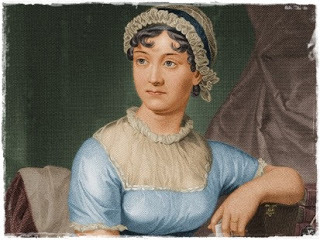
I have always written. My first attempts at novel writing—Catherine, Lesley Castle, and Lady Susan—are evidence of that. But none is quite right. The latter two works are a bit scandalous, with adultery, abandonment of children, and permissiveness beyond the ken of polite society. Years ago, when I read them aloud to the family, Father’s eyebrows rose. Yet he didn’t chastise me or tell me to stop. I thank him for being patient with me, for what good is a rector who cannot see the joke in sins and sinners?
I have also attempted a series of letters called Elinor and Marianne. I enjoy the differences between the two sisters. Perhaps I have shown that a disparity in character does not indicate a lack of character. . . .
We have always been a family of readers—my father’s library has over five hundred volumes, and I have access to them all. And though it’s not always considered delicate to admit it, we adore novels. Those of Fanny Burney, Samuel Richardson, Henry Fielding—to name three. And though I hold Fielding’s Tom Jones dear—for the fact that book inspired the dialogue between my Tom and me—my favourite is Richardson’s masterpiece, Sir Charles Grandison. It’s a massive book, populated by friends. If only I could discuss their failings and follies directly with the characters themselves.
If a book is well written, I always find it too short. The boldness in the craft that these authors possess inspires me to try my hand at it. Not that my busyness will ever amount to much.
I remember sitting in my father’s study once, reading while the boys played outside. I heard Henry in the hallway talking with Father, wanting me to come join them in a roll down the green hill behind the rectory. But Father stopped him, saying, “Leave your sister alone, she is enmeshed; she is gone from us.”
Henry (being Henry) said, “No, she is not; she is right there in your study. I saw her through the window.” Thankfully, Father held fast, protecting my privacy. His words held more than a kernel of truth. When I read a novel I’m not here. I’m transported to far-off places, my eyes unseeing of the words on the page, busy with a scene being played out in my mind’s eye, with my ears engaged, hearing the voices carry from the pen to the present. What a lovely place to be—not here.
I enjoy working in the sitting room I share with my sister, Cassandra (the blue paper on the walls here is such a balm), and she respects my time here, though, in truth, I don’t mind her presence. By her own volition she never intrudes. It’s I who occasionally request her participation. I relish her comments when I read to her a line or two out of doubt. She is very wise, and, seeing beyond what I have said, she has an ear for what I mean. I often read aloud to Mother and Father after evening tea and also accept their comments, though I admit, with less alacrity. ’Tis a distinction I fear implies too much. Mother usually asks for more description of place and costume: “But what colour is her dress, Jane?” And though I have attempted to write more of these details, it’s a forced addition that intrudes upon the words that beg to be released. Her request reminds me of a child pulling on a mother’s gown, wanting attention. Sometimes attention to the child’s needs is required, but at other times it’s best ignored.
And so, I ignore Mother’s wishes and do what I must do, and write how I must write. If a bubbling stream forces itself to become a torrent, surely disaster will follow. I am what I am, and though I’m still learning this measure and meter of words, I must be true to my nature, and yea, even my gift.
For it is a gift—from God, if I may be so bold. I say this not to imply great talent, but to indicate my awareness that I have received something beyond my own choosing. Although in essence I realize I can refuse this offering, I also sense that the prudent act, the one that begs to be tinged with sincere gratitude, requires me to do what I can with this gift and offer it back into the void from whence it came. Whether it will prosper and move along or disappear like morning fog, I don’t know. I should not care. For the gift is not truly mine to hold, but mine to use and return. To someone’s benefit. I hope.
My musings have delayed my task for the day. I must acknowledge that I have finished that which I started nine months ago. I stack the pages and align the edges. So many hours. So many thoughts—some used and many discarded. But here it sits. First Impressions, the story of the Bennet family, which was inspired by my dear Tom’s own familial condition. The two oldest Bennet sisters: Jane and Elizabeth, their names taken from my own name and Cassandra’s middle name. If someone asks if I used us as the inspiration for our namesakes, I will have to tell them no. If anything, Cassandra gives the most to Jane’s character, and I to Lizzy’s. But even then, they are not us. Not completely. And never purely. But they are two sisters, dear to each other and different from each other. In that we share a connection.
I’m reluctant to be done, for I have long lived with Lizzy and her sisters, with Mr. Darcy, and even the duplicitous Wickham. I have invested and divested in them as much as I have in my own Austen family. I’m wont to say adieu to them, as I would to those with whom I share blood ties.
I set my hand upon the pages and let a breath go in and out. It’s hard to let go, yet it’s a necessity in the birth of any child. I tie a string around the pages, adjusting its bow. A pretty package all in all.
There is a knock on the door. “Come in.”
Father opens the door, a letter in hand. “’Tis a letter from Henry, addressed to you.”
I nod and reach for it.
Father sees the pages. “You have finished?”
“I have.”
“Will you read the end to us tonight?”
“If you would like.”
He gives me a chastising look. “Of course we would like. It’s a good work, Jane. A fine accomplishment.”
“I’m happy the family is pleased with it.”
He strokes his chin, his eyes on the neat pile of pages. “Actually, I know of a man in the publishing business and I was thinking—”
My words don’t align with my thoughts. “No, Father. It’s not good enough for that.”
“Nonsense. Nothing ventured, nothing gained.” He turns toward the door. “Tomorrow I will write a proper letter of introduction. Then I will send it to this man, Thomas Cadell.”
“He will not publish it.”
Father points a finger, then flicks it toward the end of my nose. “We shall see.”
Once again I place a hand upon the pages that are mine, all mine. Until now? Until someone beyond the family reads the words? I shiver at the thought with dread—
And yes, excitement.
**
I hold on to hope. And a letter.
The letter Father wrote to the publishers in London—Cadell and Davies—is quite . . . direct. He allowed me to copy it before it was sent:
Sirs
I have in my possession a Manuscript Novel, comprised in three Vols. About the length of Miss Burney’s Evelina. As I am well aware of what consequence it is that a work of this sort should make its first appearance under a respectable name I apply to you. Shall be much obliged therefore if you will inform me whether you chuse to be concerned in it; what will be the expense of publishing at the Author’s risk; & what you will advance for the Property of it, if on perusal it is approved of?
Should your answer give me encouragement I will send you the work.
I am, Sirs, Yr. obt. hble Servt: Geo Austen
In many ways it’s an awkward letter, and if I would have had the chance to edit it . . .
I shove away such presumption. He is my father. He deals with businessmen every day. What do I know regarding the form of such correspondence?
I know that I care deeply about its outcome.
Although I’m careful not to make anyone else aware, I pore over the letter daily—actually, many times a day. I pull it out of my writing desk and imagine Mr. Cadell reading it and being intrigued, pulling a fresh piece of paper close. He dips quill to ink and writes, Sir. We would be happy to peruse such a manuscript. Please send post-haste. We have been searching for just such a novel and will surely publish it—at our expense.
I laugh at the presumption. Yet what good are dreams if they are grounded in logic and probability?
The letter also brings me great pride, for to know that Father thinks well of the story, enough to bother his day by writing a letter and by offering to have it published “at the Author’s risk” . . . I’m very blessed.
I hear Mother talking to Cook below. I have been alone in my daydreams long enough. There is work to do. Life does go on. With or without a published book by Jane Austen.
**
Tilly brings in the post, along with a gust of the November chill. I meet her near the door, eager to retrieve it. There is a letter from Aunt Leigh-Perrot in Bath, a letter from Edward, and . . .
My heart stops.
On top of the pile of three is a letter addressed to Cadell and Davies. From my father. Across the front is boldly written: Declined by Return of Post.
I turn it over. Father’s seal is broken and resealed.
They read the letter.
They returned it.
They don’t want my manuscript.
I have been rejected.
Father comes into the foyer, a book in hand. He sees me. “Ah. Letters.” He extends a hand.
I hesitate. For it’s not just I who have been rejected. All Father’s hard work, writing the letter on my behalf, believing in me . . . oddly, I feel I have failed him.
“Jane?”
I give him the three, keeping the rejection on top. He deserves to see it.
He reads the front, turns it over, then reads the front again. “Declined?”
“They read it but—”
His voice rises. “Declined?”
I take the offending letter away, moving it behind my back. Out of sight. “It was a great risk, Father. I’m too great a risk. For who will take seriously anything penned by a parson’s daughter living in Hampshire? I have no standing, no right, no—”
“But declined?”
I point to Edward’s letter, which graces the top of the pile. “Go. Read what your son has to say.”
He nods and turns away, then back to me. “I’m sorry, Jane. It’s a good story.”
“You tried, Father. I will always remember that.” I kiss his cheek.
He goes back to his study.
And I?
I remove the letter from behind my back and stare at it. My silly imaginings of Cadell writing a far different response evaporate. I need to take the words I have just spoken with such false bravery to Father and hold them as truth: Who am I to expect a publisher to care about my work? I’m no one, beyond obscure, never to be known beyond the tight boundaries of tiny Steventon.
Who am I to expect more? Want more? Dream of more?
I retreat to my sitting room and close the door. I open the trunk that holds the evidence of my folly—my follies. Manuscripts written strictly for the amusement of my family. And myself. For I do enjoy the writing process. I do enjoy creating another place and time, populating it with people who could be as outrageous, vainglorious, courageous, or victorious as I will them to be. Through my writing I capture a smidgen of control—if not in my own life, in the lives of my characters. Their happiness, success, justice, or demise depends on me.
If only I had as much control over my own fate. My mind wanders to thoughts of Tom. . . . If only he would come home from his law studies and take me away from all this. Rescue me.
But alas, such happy endings happen only in novels.
Novels that will never be published.
I look down on the stacks of paper, so neatly tied. Hours and hours, days and days of my life . . .
Wasted.
I slip Father’s letter under the bow of First Impressions. The word Declined peeks back at me, teasing me.
Condemning me.
I close the lid of the trunk.
The lid of my dreams.
***
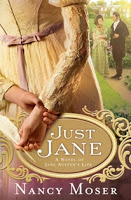
Just JaneNancy again: So, dear writing friends, take heart in the disappointments, the excitement, the hard work, and the rejections that come with the writing life. Know that every writer before and after experiences the same things. And remember the rewards exist in all of those pesky emotions. The reward is in the journey//Nancy

But just a few moments ago, as I read about Jane's angst and her dreams, I thought of all of us writers, here at the conference, over two hundred years after Jane wrote her immortal novels. The years fall away as we see that her issues, doubts, and hopes are ours.
Read about Jane Austen’s writing life, from her point-of-view, as she struggles to be Just Jane. See how her struggles are our struggles… (FYI: her manuscript First Impressions became Pride & Prejudice.)
Just Jane (Chapter 4)

I have always written. My first attempts at novel writing—Catherine, Lesley Castle, and Lady Susan—are evidence of that. But none is quite right. The latter two works are a bit scandalous, with adultery, abandonment of children, and permissiveness beyond the ken of polite society. Years ago, when I read them aloud to the family, Father’s eyebrows rose. Yet he didn’t chastise me or tell me to stop. I thank him for being patient with me, for what good is a rector who cannot see the joke in sins and sinners?
I have also attempted a series of letters called Elinor and Marianne. I enjoy the differences between the two sisters. Perhaps I have shown that a disparity in character does not indicate a lack of character. . . .
We have always been a family of readers—my father’s library has over five hundred volumes, and I have access to them all. And though it’s not always considered delicate to admit it, we adore novels. Those of Fanny Burney, Samuel Richardson, Henry Fielding—to name three. And though I hold Fielding’s Tom Jones dear—for the fact that book inspired the dialogue between my Tom and me—my favourite is Richardson’s masterpiece, Sir Charles Grandison. It’s a massive book, populated by friends. If only I could discuss their failings and follies directly with the characters themselves.
If a book is well written, I always find it too short. The boldness in the craft that these authors possess inspires me to try my hand at it. Not that my busyness will ever amount to much.
I remember sitting in my father’s study once, reading while the boys played outside. I heard Henry in the hallway talking with Father, wanting me to come join them in a roll down the green hill behind the rectory. But Father stopped him, saying, “Leave your sister alone, she is enmeshed; she is gone from us.”
Henry (being Henry) said, “No, she is not; she is right there in your study. I saw her through the window.” Thankfully, Father held fast, protecting my privacy. His words held more than a kernel of truth. When I read a novel I’m not here. I’m transported to far-off places, my eyes unseeing of the words on the page, busy with a scene being played out in my mind’s eye, with my ears engaged, hearing the voices carry from the pen to the present. What a lovely place to be—not here.
I enjoy working in the sitting room I share with my sister, Cassandra (the blue paper on the walls here is such a balm), and she respects my time here, though, in truth, I don’t mind her presence. By her own volition she never intrudes. It’s I who occasionally request her participation. I relish her comments when I read to her a line or two out of doubt. She is very wise, and, seeing beyond what I have said, she has an ear for what I mean. I often read aloud to Mother and Father after evening tea and also accept their comments, though I admit, with less alacrity. ’Tis a distinction I fear implies too much. Mother usually asks for more description of place and costume: “But what colour is her dress, Jane?” And though I have attempted to write more of these details, it’s a forced addition that intrudes upon the words that beg to be released. Her request reminds me of a child pulling on a mother’s gown, wanting attention. Sometimes attention to the child’s needs is required, but at other times it’s best ignored.
And so, I ignore Mother’s wishes and do what I must do, and write how I must write. If a bubbling stream forces itself to become a torrent, surely disaster will follow. I am what I am, and though I’m still learning this measure and meter of words, I must be true to my nature, and yea, even my gift.
For it is a gift—from God, if I may be so bold. I say this not to imply great talent, but to indicate my awareness that I have received something beyond my own choosing. Although in essence I realize I can refuse this offering, I also sense that the prudent act, the one that begs to be tinged with sincere gratitude, requires me to do what I can with this gift and offer it back into the void from whence it came. Whether it will prosper and move along or disappear like morning fog, I don’t know. I should not care. For the gift is not truly mine to hold, but mine to use and return. To someone’s benefit. I hope.
My musings have delayed my task for the day. I must acknowledge that I have finished that which I started nine months ago. I stack the pages and align the edges. So many hours. So many thoughts—some used and many discarded. But here it sits. First Impressions, the story of the Bennet family, which was inspired by my dear Tom’s own familial condition. The two oldest Bennet sisters: Jane and Elizabeth, their names taken from my own name and Cassandra’s middle name. If someone asks if I used us as the inspiration for our namesakes, I will have to tell them no. If anything, Cassandra gives the most to Jane’s character, and I to Lizzy’s. But even then, they are not us. Not completely. And never purely. But they are two sisters, dear to each other and different from each other. In that we share a connection.
I’m reluctant to be done, for I have long lived with Lizzy and her sisters, with Mr. Darcy, and even the duplicitous Wickham. I have invested and divested in them as much as I have in my own Austen family. I’m wont to say adieu to them, as I would to those with whom I share blood ties.
I set my hand upon the pages and let a breath go in and out. It’s hard to let go, yet it’s a necessity in the birth of any child. I tie a string around the pages, adjusting its bow. A pretty package all in all.
There is a knock on the door. “Come in.”
Father opens the door, a letter in hand. “’Tis a letter from Henry, addressed to you.”
I nod and reach for it.
Father sees the pages. “You have finished?”
“I have.”
“Will you read the end to us tonight?”
“If you would like.”
He gives me a chastising look. “Of course we would like. It’s a good work, Jane. A fine accomplishment.”
“I’m happy the family is pleased with it.”
He strokes his chin, his eyes on the neat pile of pages. “Actually, I know of a man in the publishing business and I was thinking—”
My words don’t align with my thoughts. “No, Father. It’s not good enough for that.”
“Nonsense. Nothing ventured, nothing gained.” He turns toward the door. “Tomorrow I will write a proper letter of introduction. Then I will send it to this man, Thomas Cadell.”
“He will not publish it.”
Father points a finger, then flicks it toward the end of my nose. “We shall see.”
Once again I place a hand upon the pages that are mine, all mine. Until now? Until someone beyond the family reads the words? I shiver at the thought with dread—
And yes, excitement.
**
I hold on to hope. And a letter.
The letter Father wrote to the publishers in London—Cadell and Davies—is quite . . . direct. He allowed me to copy it before it was sent:
Sirs
I have in my possession a Manuscript Novel, comprised in three Vols. About the length of Miss Burney’s Evelina. As I am well aware of what consequence it is that a work of this sort should make its first appearance under a respectable name I apply to you. Shall be much obliged therefore if you will inform me whether you chuse to be concerned in it; what will be the expense of publishing at the Author’s risk; & what you will advance for the Property of it, if on perusal it is approved of?
Should your answer give me encouragement I will send you the work.
I am, Sirs, Yr. obt. hble Servt: Geo Austen
In many ways it’s an awkward letter, and if I would have had the chance to edit it . . .
I shove away such presumption. He is my father. He deals with businessmen every day. What do I know regarding the form of such correspondence?
I know that I care deeply about its outcome.
Although I’m careful not to make anyone else aware, I pore over the letter daily—actually, many times a day. I pull it out of my writing desk and imagine Mr. Cadell reading it and being intrigued, pulling a fresh piece of paper close. He dips quill to ink and writes, Sir. We would be happy to peruse such a manuscript. Please send post-haste. We have been searching for just such a novel and will surely publish it—at our expense.
I laugh at the presumption. Yet what good are dreams if they are grounded in logic and probability?
The letter also brings me great pride, for to know that Father thinks well of the story, enough to bother his day by writing a letter and by offering to have it published “at the Author’s risk” . . . I’m very blessed.
I hear Mother talking to Cook below. I have been alone in my daydreams long enough. There is work to do. Life does go on. With or without a published book by Jane Austen.
**
Tilly brings in the post, along with a gust of the November chill. I meet her near the door, eager to retrieve it. There is a letter from Aunt Leigh-Perrot in Bath, a letter from Edward, and . . .
My heart stops.
On top of the pile of three is a letter addressed to Cadell and Davies. From my father. Across the front is boldly written: Declined by Return of Post.
I turn it over. Father’s seal is broken and resealed.
They read the letter.
They returned it.
They don’t want my manuscript.
I have been rejected.
Father comes into the foyer, a book in hand. He sees me. “Ah. Letters.” He extends a hand.
I hesitate. For it’s not just I who have been rejected. All Father’s hard work, writing the letter on my behalf, believing in me . . . oddly, I feel I have failed him.
“Jane?”
I give him the three, keeping the rejection on top. He deserves to see it.
He reads the front, turns it over, then reads the front again. “Declined?”
“They read it but—”
His voice rises. “Declined?”
I take the offending letter away, moving it behind my back. Out of sight. “It was a great risk, Father. I’m too great a risk. For who will take seriously anything penned by a parson’s daughter living in Hampshire? I have no standing, no right, no—”
“But declined?”
I point to Edward’s letter, which graces the top of the pile. “Go. Read what your son has to say.”
He nods and turns away, then back to me. “I’m sorry, Jane. It’s a good story.”
“You tried, Father. I will always remember that.” I kiss his cheek.
He goes back to his study.
And I?
I remove the letter from behind my back and stare at it. My silly imaginings of Cadell writing a far different response evaporate. I need to take the words I have just spoken with such false bravery to Father and hold them as truth: Who am I to expect a publisher to care about my work? I’m no one, beyond obscure, never to be known beyond the tight boundaries of tiny Steventon.
Who am I to expect more? Want more? Dream of more?
I retreat to my sitting room and close the door. I open the trunk that holds the evidence of my folly—my follies. Manuscripts written strictly for the amusement of my family. And myself. For I do enjoy the writing process. I do enjoy creating another place and time, populating it with people who could be as outrageous, vainglorious, courageous, or victorious as I will them to be. Through my writing I capture a smidgen of control—if not in my own life, in the lives of my characters. Their happiness, success, justice, or demise depends on me.
If only I had as much control over my own fate. My mind wanders to thoughts of Tom. . . . If only he would come home from his law studies and take me away from all this. Rescue me.
But alas, such happy endings happen only in novels.
Novels that will never be published.
I look down on the stacks of paper, so neatly tied. Hours and hours, days and days of my life . . .
Wasted.
I slip Father’s letter under the bow of First Impressions. The word Declined peeks back at me, teasing me.
Condemning me.
I close the lid of the trunk.
The lid of my dreams.
***

Just JaneNancy again: So, dear writing friends, take heart in the disappointments, the excitement, the hard work, and the rejections that come with the writing life. Know that every writer before and after experiences the same things. And remember the rewards exist in all of those pesky emotions. The reward is in the journey//Nancy
Published on September 22, 2012 08:51
September 17, 2012
The Craziness of Crazy Quilts
 Have you ever tried to make a crazy quilt? I have. Zounds. It seems like it would be simple because the concept is to take odd-shaped pieces and put them together in any-which way you choose. Sounds good to me. Regular patchwork doesn’t always work for me because I’m not as exact as I should be.
Have you ever tried to make a crazy quilt? I have. Zounds. It seems like it would be simple because the concept is to take odd-shaped pieces and put them together in any-which way you choose. Sounds good to me. Regular patchwork doesn’t always work for me because I’m not as exact as I should be.Crazy quilts simple? Yikes. Hardly.
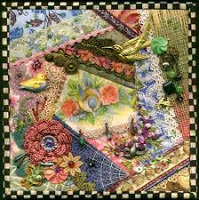 Quilt block by Janet Stauffacher
Quilt block by Janet Stauffacher Unfortunately, I jumped into crazy quilting like I jump into a lot of artsy-crafty projects that catch my eye and make me stupidly think "Hey, I could do that!" For instance, I have a whole set of lace-making bobbins and a pillow with the lace pins on it. That fad lasted about a week before I realized it was far easier and wiser to buy my lace by the yard. Then, since my dad carves and paints birds (even at age 93) I assumed I should have the same talented genes. So I bought some balsa wood and carving knives and hacked off the corner of the wood. One little corner. My hands hurt at the effort. It was harder than I thought! I also remember getting paint and canvas after I was inspired by Bob Ross (Mr. Happy Clouds.) I still have them. Only slightly used.
I digress. But as I dove into the art of crazy-quilting, I decided I was going to make a king-sized spread (I know, I know. What was I thinking?) I went to the fabric store and spent over $100 buying luscious fabrics in deep jewel tones. I bought a couple books on the craft, ones that offered me different embroidery stitches. For you see, along the seam of each oddly shaped piece of fabric, you’re supposed to embellish it with embroidery and beads and bits of lace. I bought $30 worth of floss and thread and a packet of needles. You can never have too many needles. And why not one of those nifty cutting boards with a rotary cutter? After 50 years of sewing, it was time to move up from mere scissors. $60? Why not.
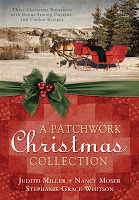 I was set to go.
I was set to go.But then, on the first day, I realized piecing together unusual, haphazard pieces of fabric was far from easy. It was hard to think in this abstract way. I gave it a couple more days, but I soon realized that I would be better off sewing together 3” x 8” rectangular strips and add my embroidery along those seams. So that's what I did. For a short time. After creating about twelve blocks, I set it aside.
For now. Until the next surge of inspiration comes along.
But my experience with my ridiculously crazy quilt gave me the idea for a novella. The Bridal Quilt is just out in a Christmas anthology that I wrote with Stephanie Grace Whitson and Judith Miller. The book is called A Patchwork Christmas. Each novella revolves around the holiday and a quilt. Judith’s story is about the Amana colonies in Iowa, Stephanie’s is about Nebraska, and mine is set in 1880's New York City, during the Gilded Age. My character, Ada, is a wealthy ingénue and is making a bridal quilt out of all the lovely fabric scraps from dresses she’s worn since coming out into society. Ada’s quilt is a success.
Good for her.
Actually, good for me. And you. Because included in the book are directions to knit Amana-style mittens, sew a patchwork doll quilt, and create a crazy quilt ornament like the one on the right And there's a contest to win one of these finished pieces of crafty-artistry! Whoever wins this ornament better appreciate it because it took all my inconsiderable talent to make it. Yes, I made it. And I'm giving it away. See info about the contest here. By the way, Lincoln Nebraska has an amazing International Quilt Study Center and Museum. I heartily recommend it. Awhile ago they had a display on Victorian crazy quilts. Here's a link. Browse through the rest of the website too. Happy Creativity!//Nancy
Published on September 17, 2012 18:44
September 10, 2012
The Home of the Friendless
The Home of the Friendless and The Shadow on the Quilt “Here lies Julia Adams … who died of thin shoes.” That’s an actual epitaph, according to a book of epitaphs I just tried to find here in my office. Sometimes my books seem to take on a life of their own and just when I need a specific title—poof—it’s gone. But that’s another blog post.
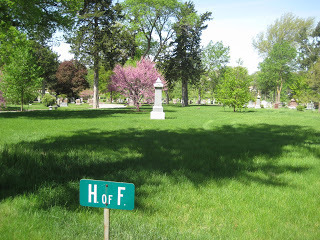
Today, I thought I’d share a book idea that sprang up over ten years ago and then just wouldn’t go away. I saw this sign at a local cemetery. H. of F.? Hunh? I asked at the cemetery and was told the letters stood for Home of the Friendless. The phrase wouldn’t go away. Since I love prowling about in the historical archives here in my home town, I finally asked about the “Home of the Friendless” one day. (This was before we could “google” and know everything.) I learned: “In 1876 … charitable women of Nebraska organized a society known as the ‘Home of the Friendless,’ … to furnish a refuge for friendless children, girls, young women, and old ladies.” By 1881, “so many friendless and deserted children came to our doors requiring protections that the state legislature … appropriated the sum of $5,000 to assist the society by the erection of a permanent building.” Here’s a photo of the Home of the Friendless from around 1917.
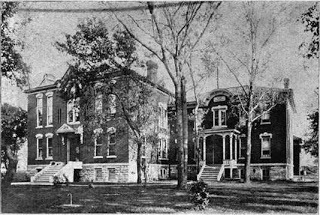 Most of us don’t really think of the 1870s and 1880s as a time when many people were “friendless.” We think of it as a kinder and gentler time. Sort of “little-house-on-the-prairie-ish.” But 1876 was a dismal time in Nebraska. Thanks to hordes of grasshoppers, “property fell to ruinously low prices, farmers had little to buy with, and hundreds not only left their farms, but the town of Lincoln also.” I spent several days at the archives squinting at hand-written meeting minutes from the early days of this organization, and the more I read, the more enthusiastic I became about writing a story that would revolve around this compassionate ministry. They hired a full-time Matron (for $25 a month.) A Matron. Ah … a character for a story. (You’ll meet mine if you read The Shadow on the Quilt). “Mrs. X will furnish the parlor and hall with carpets and curtains, parlor and back parlor for a bedroom …” Ah. Mrs. X must have been rich. (Enter Juliana Sutton, the heroine in my novel.) I kept reading. More story ideas emerged. In August of 1883 an “interesting old lady” was admitted at $3 a week board. “Two little babies were brought to the home … we do not think they will live.” A boy who had been adopted out was being brought back because of “dissatisfaction.” He was returned to the home and then taken by another couple “who had his little sister.” “Mrs D. was hired to work in the nursery for $8 a month plus the boarding of her three children.” A note in the meeting minutes from July, 1886, made me think of that sign at the cemetery. “The committee on cemetery grounds reported the old lots nicely planted with bedding plants from the greenhouse and the new lots to be graded and sodded by fall.” Ah. I could have someone interested in the final resting places of the “friendless.” And so, finally … The Shadow on the Quilt, just released by Barbour Publishing.
Most of us don’t really think of the 1870s and 1880s as a time when many people were “friendless.” We think of it as a kinder and gentler time. Sort of “little-house-on-the-prairie-ish.” But 1876 was a dismal time in Nebraska. Thanks to hordes of grasshoppers, “property fell to ruinously low prices, farmers had little to buy with, and hundreds not only left their farms, but the town of Lincoln also.” I spent several days at the archives squinting at hand-written meeting minutes from the early days of this organization, and the more I read, the more enthusiastic I became about writing a story that would revolve around this compassionate ministry. They hired a full-time Matron (for $25 a month.) A Matron. Ah … a character for a story. (You’ll meet mine if you read The Shadow on the Quilt). “Mrs. X will furnish the parlor and hall with carpets and curtains, parlor and back parlor for a bedroom …” Ah. Mrs. X must have been rich. (Enter Juliana Sutton, the heroine in my novel.) I kept reading. More story ideas emerged. In August of 1883 an “interesting old lady” was admitted at $3 a week board. “Two little babies were brought to the home … we do not think they will live.” A boy who had been adopted out was being brought back because of “dissatisfaction.” He was returned to the home and then taken by another couple “who had his little sister.” “Mrs D. was hired to work in the nursery for $8 a month plus the boarding of her three children.” A note in the meeting minutes from July, 1886, made me think of that sign at the cemetery. “The committee on cemetery grounds reported the old lots nicely planted with bedding plants from the greenhouse and the new lots to be graded and sodded by fall.” Ah. I could have someone interested in the final resting places of the “friendless.” And so, finally … The Shadow on the Quilt, just released by Barbour Publishing.
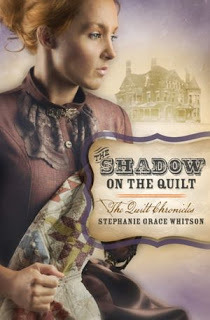 Some of the entries in those historical documents broke my heart. Some inspired me to thank my heavenly Father for the boundless blessings I knew when I was raising my four children. When I became as single mother, I wasn’t friendless like this woman in 1881: “A young mother was brought to the gate of this Home with a three days old baby. I took the child as she came to the steps and carried it to the nursery. Also assisted her to a room. In a week she was able to work and we found her good help. Her child is healthy and growing nicely. She has given it to the home.” Today, never-married mothers aren’t treated like pariahs. “July 8—I received a letter asking the admittance of a young girl, one of the deceived and deserted ones. At first my heart rebelled when this class of inmates came, but after knowing them better my heart turns toward them, and I have done what I could to lead them to a better life.” The Shadow on the Quilt is my tribute to the women who created the Home for the Friendless in 1876; God’s extraordinary women who saw a need and filled it. Extraordinary women who believed in an eternity where the word “friendless” will no longer be needed.
Some of the entries in those historical documents broke my heart. Some inspired me to thank my heavenly Father for the boundless blessings I knew when I was raising my four children. When I became as single mother, I wasn’t friendless like this woman in 1881: “A young mother was brought to the gate of this Home with a three days old baby. I took the child as she came to the steps and carried it to the nursery. Also assisted her to a room. In a week she was able to work and we found her good help. Her child is healthy and growing nicely. She has given it to the home.” Today, never-married mothers aren’t treated like pariahs. “July 8—I received a letter asking the admittance of a young girl, one of the deceived and deserted ones. At first my heart rebelled when this class of inmates came, but after knowing them better my heart turns toward them, and I have done what I could to lead them to a better life.” The Shadow on the Quilt is my tribute to the women who created the Home for the Friendless in 1876; God’s extraordinary women who saw a need and filled it. Extraordinary women who believed in an eternity where the word “friendless” will no longer be needed.July 28, 1881 “Our dear little patient Hazel has gone to the home where sin and poverty will never enter, and where she will not be friendless, for Jesus has taken her to himself.”
Published on September 10, 2012 19:36
September 3, 2012
The Home of the Friendless and The Shadow on the Quilt
I'll share the entire blog post here in a few days here ... but thought I'd mention that I'm talking about the real history behind my new release over at http://www.writespassage.blogspot.com/ today (Monday).

Published on September 03, 2012 21:48
August 23, 2012
1879 at Fort Omaha, Nebraska
 History lovers learn a couple of things fairly early on. One is DON'T TOUCH ... another is ASK before taking photos. I learned the last rule when I was a nineteen-year-old student standing atop this staircase staring with wonder up at La Victoire de Samothrace. Had Paul seen her on one of his journeys? I had to have a photograph. To remind myself that I'd been here. Happily, French docents seem less likely to toss a person out on their ear if they happen to be a pretty nineteen-year-old. I survived the scolding, but I had learned the rule. Never forgot it, either.
History lovers learn a couple of things fairly early on. One is DON'T TOUCH ... another is ASK before taking photos. I learned the last rule when I was a nineteen-year-old student standing atop this staircase staring with wonder up at La Victoire de Samothrace. Had Paul seen her on one of his journeys? I had to have a photograph. To remind myself that I'd been here. Happily, French docents seem less likely to toss a person out on their ear if they happen to be a pretty nineteen-year-old. I survived the scolding, but I had learned the rule. Never forgot it, either. 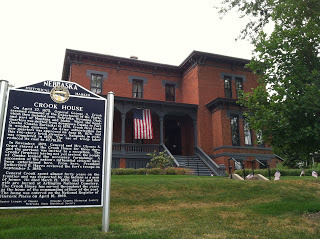
So imagine my amazement when I visited the gorgeous 1879 Victorian home pictured on the left a couple of Sundays ago and was invited to take all the photos I wanted to take ... to sit on the furniture ... so hold the teacup ... even to play the piano. The General Crook House at Fort Omaha, Nebraska, is heaven for the history-lover, and especially wonderful for someone like me who has to create imaginary worlds for her characters to inhabit.
The house would have been three-and-a-half miles outside of Omaha when it was built. "On the frontier," the docent explained. Presidents Rutherford B. Hayes and Ulysses Grant both stayed at this house (I'll show you the guest room in my next post).
I have authentic house plans ... books of them. But there is nothing like 3-D to get my imagination going. That wallpaper! That arched doorway! That silver tea set! That lamp! That chandelier ... and the fireplaces burned coal. Now I know how my people heat their house.
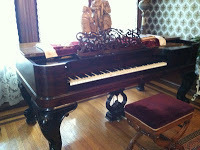 This is the piano I played. An 1858 model. And it was in tune.I'll just share a few highlights, but if you are ever near this place and you love the Victorian era ... you MUST GO. I'm going back at Christmas. Or before. Because it was impossible to see everything. I want time to savor. To close my eyes and imagine.
This is the piano I played. An 1858 model. And it was in tune.I'll just share a few highlights, but if you are ever near this place and you love the Victorian era ... you MUST GO. I'm going back at Christmas. Or before. Because it was impossible to see everything. I want time to savor. To close my eyes and imagine.A step back in time ... although I wouldn't want to go back. I also saw the maid's quarters ... which is where I would have lived.
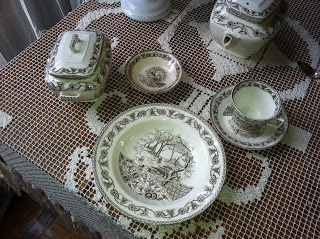 Everyday china in the breakfast nook.
Everyday china in the breakfast nook.MORE SOON! ..............................................Stephanie
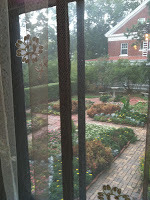 And the view of the garden from the breakfast nook.
And the view of the garden from the breakfast nook.
Published on August 23, 2012 20:43
August 15, 2012
TECHNO-TROUBLES
Well ... if you've checked us out recently you've seem one combination or another of ... a mess. So I've made the monumental decision to simplify and eliminate the chaos until we figure out the problem. We're back ... we just aren't as "pretty." Hope you stay tuned! --Stephanie G.
Published on August 15, 2012 07:05



